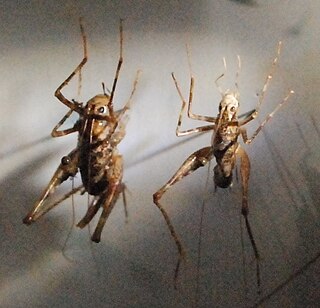
The Tettigoniinae are a subfamily of bush crickets or katydids, which contains hundreds of species in about twelve tribes.

Trigonidiinae is a subfamily of insects in the order Orthoptera, suborder Ensifera, based on the type genus Trigonidium. They are often referred to as sword-tail crickets, winged bush crickets or trigs.

Phalangopsinae, occasionally known as spider crickets, are a subfamily of crickets in the family Phalangopsidae. Members of Phalangopsinae are found worldwide in tropical and subtropical regions. Most species in the subfamily are nocturnal and can be found in rocky areas, near fallen wood, and the understory of forests. Some species are gregarious, gathering in large numbers.

The Eneopterinae are a subfamily of crickets, in the family Gryllidae, based on the type genus Eneoptera. It is one of several groups widely described as "true crickets", but this subfamily may also referred to in American English as "bush crickets". Of the more than 500 species that make up this subfamily, most occur in moist, tropical habitats. These insects are medium to large and brown or gray in color. They eat plant leaves, flowers, and fruits and can occasionally cause economic damage. Their eggs are deposited in pith, bark, or wood. Eneopterinae show a great diversity in stridulatory apparatus, signals emitted, and associated behaviour.

Gryllomorpha is a genus of cricket belonging to the family Gryllidae subfamily Gryllomorphinae. The species of this genus are present in Europe, in North Africa and in Central Asia.

Mogoplistidae is a family of scaly crickets within the superfamily Grylloidea. Considered to be monophyletic, a sister taxon to the Gryllidae crickets. This family consists of more than 370 species worldwide; 20 species in 4 genera occur in North America and this family includes the scaly crickets of Europe.

Podoscirtinae is a subfamily of crickets in the family Gryllidae.

Metioche is a genus of sword-tail crickets in the tribe Trigonidiini. Species have been found in tropical South America, Africa, Asia and Australia.

Pteronemobius is a genus of crickets in the subfamily Nemobiinae, with a worldwide distribution.

Dolichopoda is a genus of cave crickets in the tribe Dolichopodaini, subfamily Dolichopodainae. They are distributed in the Mediterranean basin in southern Europe and western Asia.

Modicogryllini is a tribe of crickets in the family Gryllidae. Species are terrestrial, carnivorous or omnivorous and can be found in all continenents except Antarctica.

Gryllini is a tribe of crickets and typical of the family Gryllidae. Species are terrestrial, carnivorous or omnivorous and can be found in all continenents except Antarctica.

Homoeoxipha is a genus of "sword-tail crickets", in the subfamily Trigonidiinae and the tribe Trigonidiini.

Uromenus is a genus of bush crickets in the sub-family Bradyporinae and tribe Ephippigerini.

The Gryllomorphinae are a subfamily of crickets based on the type genus Gryllomorpha. Species have been recorded from: North Africa and the western Palaearctic (mainland).
Sciobia is a genus of crickets in the family Gryllidae and monotypic tribe Sciobiini; it was erected by Hermann Burmeister in 1838. Species can be found in NW Africa and the Iberian peninsula.

Troglophilus is a genus of European cave crickets in the monotypic subfamily Troglophilinae; both taxa were erected by Hermann August Krauss in 1879. Species are distributed especially in the Mediterranean area, with records from Germany through to Turkey.

Ornebius is a genus of crickets in the family Mogoplistidae and the tribe Arachnocephalini, erected by Félix Édouard Guérin-Méneville in 1844. Species may be called "common scaled crickets" and have widespread records of distribution, which are discontinuous ; they include: Africa, Asia, Australia, islands in the Indian and Pacific Oceans, and South America.

Montana is a genus of bush crickets in the tribe Platycleidini, erected by F.E. Zeuner in 1941. The type species, M. montana has been called the "Steppe Bush-Cricket". Some authorities previously placed this as a subgenus of Platycleis, but it is now considered a separate genus, as part of the genus group Platycleis. Species can be found in the northern Palaearctic realm from mainland western Europe through to Siberia.


















